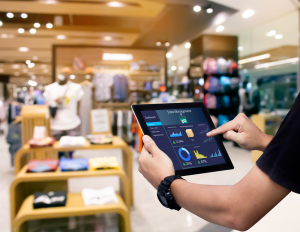Retailers are investing heavily in retail media networks (RMNs), transforming in-store screens, kiosks, and digital signage into high-value advertising real estate. Brands are eager to connect with shoppers closer to the point of purchase — but the question remains: Are retailers measuring if these ads actually work?
For many, campaign performance still relies on assumptions or anecdotal feedback rather than measurable, verified impact. Without concrete in-store attribution data, proving campaign ROI becomes guesswork — and that’s a missed opportunity for both retailers and advertisers.
That’s where Walkbase steps in. With precision attribution analytics, Walkbase connects the dots between retail media spend and real-world customer actions, helping retailers confidently optimize campaigns and prove value with retail ROI measurement.
What Is In-Store Attribution and Why It Matters

Retail attribution in a physical store environment is the process of tracking and analyzing shopper behavior to measure the impact of retail media networks and determine how in-store media influenced their actions — from visiting a particular area to making a purchase.
Unlike online attribution, where clicks, views, and conversions can be tied to a single user journey, in-store attribution requires advanced location and behavior tracking. Instead of last-click or multi-touch models, attribution in physical retail focuses on metrics such as:
- Foot traffic — how many shoppers entered a store or area during the campaign
- Dwell time and likelihood to see — how long they stayed near the advertised product or promotion
- Interaction and conversion — whether they engaged with the product and ultimately purchased
For RMNs, this is crucial. Without in-store attribution analytics for retailers, brands can’t clearly see whether their campaigns drive the desired outcomes — and retailers can’t justify premium ad rates or secure repeat investment. How much sales lift on an advertised product came from the ad running on the endcap screen in the home decor department, compared to the same ad running on the display near the store entrance on the same day? Do you have the data to prove that?
Learn more about measuring the impact of in-store retail media.
Real-World Examples: Attribution in Action

Walkbase enables retailers to measure the true effect of in-store campaigns using accurate, real-time data. Here are three ways attribution transforms campaign evaluation:
- QSR Promotion Boosting Line Speed and Upsell
A quick service restaurant launches an in-store upsell campaign for a premium meal add-on. Attribution analytics reveal that, post-promotion, customers choose the upsell option more frequently — and order processing time remains fast, preserving operational efficiency. - Screen Exposure to Dwell Time and Purchase
A retailer installs large-format screens near the entrance, promoting a seasonal product. Using Walkbase’s sensor technology and attribution tools, they track how exposure correlates with increased dwell time in the featured department and match this to an uplift in sales during the campaign period. - In-Aisle Ad Driving Product Lift
A brand advertises a new snack on an endcap digital display. Walkbase data shows not only increased traffic to the aisle but also a measurable lift in product sales compared to a baseline period, proving the display’s influence when linked to a retailer’s customer data platform.
See more about retail media measurement for in-store networks.
Tools and Data That Make Attribution Possible
Walkbase’s technology stack combines multiple data sources to create a full picture of in-store customer behavior:
- Traffic counters — Measure total store and zone-specific entries.
- Beacons and sensors — Detect proximity to in-store media placements.

All data is anonymized and GDPR-compliant, ensuring shopper privacy while delivering actionable insights.
The real value comes from connecting ad exposures to actions — such as visits, dwell time, interactions, and conversions — so retailers can move beyond impressions and focus on measurable influence.
Discover how Walkbase TREQ reveals the in-store journey.
Proving Campaign ROI With Confidence
Once data is collected, Walkbase applies advanced attribution models to reveal campaign performance:
- Incrementality — Comparing results between exposed and non-exposed shoppers.
- Time-based — Measuring changes in traffic or sales during campaign windows.
- Geo-lift — Comparing stores or zones with and without the campaign running.
Key KPIs include:
- Dwell time increase and impressions in key areas and by screen or ad unit
- Product sales uplift for promoted SKUs
- Repeat visit rates during and after campaigns
- Time to conversion from first exposure to purchase
By presenting advertisers with clear, quantifiable results, retailers can build trust, justify ad pricing, and secure ongoing partnerships. Verifiable retail ROI measurement also drives increased demand for your existing in-store RMN inventory, making it easier to justify the expense of additional ad placements in strategic locations.
Attribution Is No Longer Optional
In a competitive retail media landscape, proof is everything. In-store attribution not only validates campaign effectiveness but also fuels smarter strategy, better content placement, and higher ROI for brands.
Walkbase empowers retailers to close the loop between retail media spend and real-world outcomes — turning screens into proven sales drivers and advertisers into long-term partners.
Ready to prove what’s working in-store? Talk to Walkbase today.



